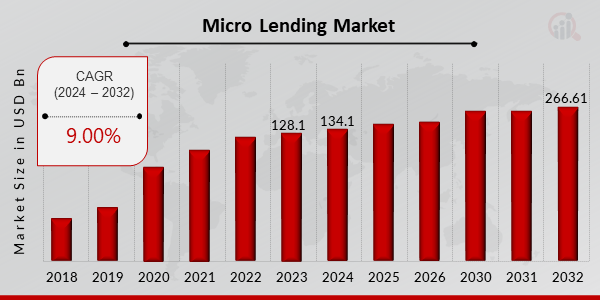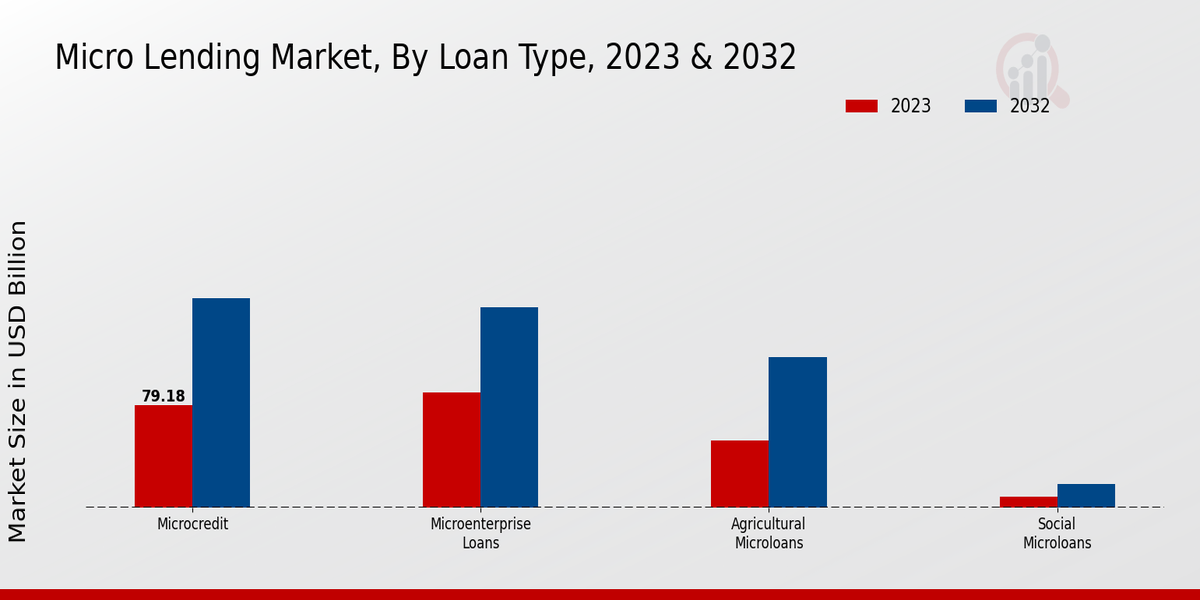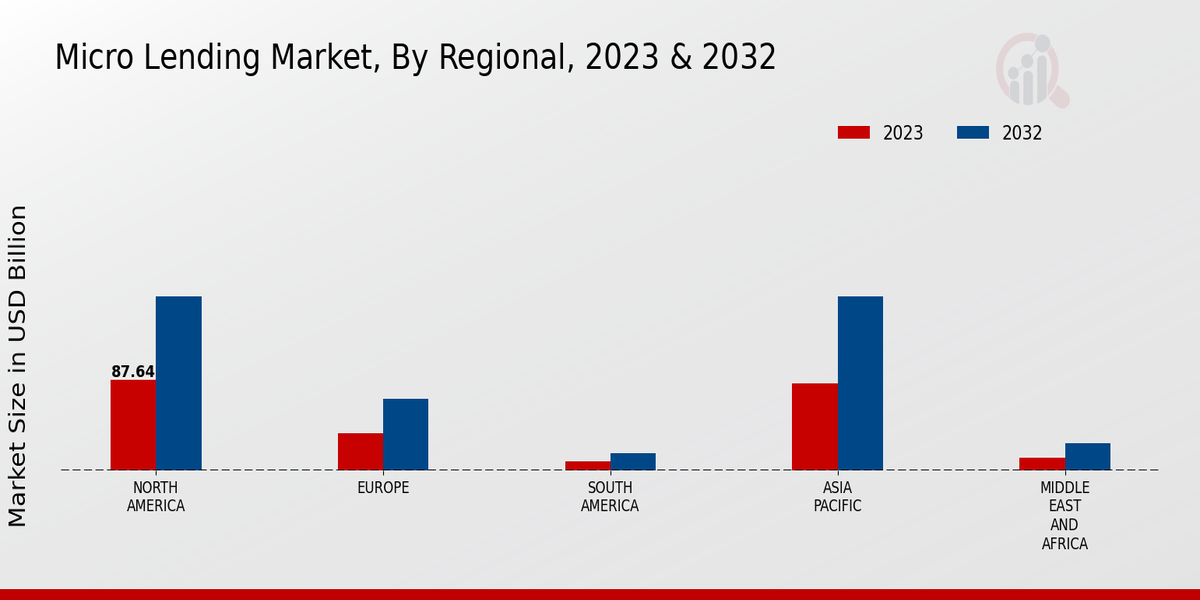Global Micro Lending Market Overview:
The Micro Lending Market Size was estimated at 128.1 (USD Billion) in 2023. The Micro Lending Market Industry is expected to grow from 134.1 (USD Billion) in 2024 to 266.61 (USD Billion) by 2032. The Micro Lending Market CAGR (growth rate) is expected to be around 9.00% during the forecast period (2024 - 2032).
Key Micro Lending Market Trends Highlighted
The micro lending market is experiencing significant growth, driven by factors such as rising financial inclusion initiatives, increasing demand for small-scale financing, and advancements in digital technologies. Opportunities lie in expanding into underserved markets, developing innovative loan products, and leveraging mobile and fintech platforms. Trends in recent times include increased adoption of digital channels, collaboration between microfinance institutions and technology providers, and a focus on financial literacy and customer education. By addressing these trends and leveraging the opportunities, micro lending institutions can enhance their reach, improve financial inclusion, and drive sustainable growth.

Source: Primary Research, Secondary Research, MRFR Database and Analyst Review
Micro Lending Market Drivers
Increased Financial Inclusion
Micro lending is contributing to an already universally increasing trend of financial inclusion. The function and the essence of financial intermediaries have always been to provide services and monetarily support individuals or businesses in need. Thus, by extending their services to people and small businesses, banks are excluded from the pool of those who have been underserved by the financial industry. As the prevalence and number of MFIs and the scale of the microcredit programs continue to grow, more and more individuals and businesses get access to credit, saving, and other financial services.This, in turn, helps people to improve their businesses, upgrade their living conditions, and build their assets. In the following years, the emphasis on financial inclusion is likely to remain one of the crucial drives of the micro lending market worldwide.
Technological Advancements
Advances in technology have changed the micro lending industry radically. The emergence of mobile technology, cloud technology, and data analytics has extended the outreach of MFIs, increased their efficiency and reduced costs. Depending on borrowing applications has simplified loan access, debt repayment and investment management. MFIs have also been able to determine the creditworthiness of their clients rationally by employing data analytics, which has reduced defaults.
Such growth in the use of technology will continue to be the key driver behind the growth of the Micro Lending Market Industry.
Government Support and Regulations
The role of government in the development and progress of the micro lending sector cannot be ignored. Governments in various countries have taken the initiative to ensure that their citizen gains financial stability. The government has been at the forefront in ensuring that they create favorable policies and regulations in promoting financial inclusion and developing the micro lending sectors. The government is also offering incentives and supporting integration between MFIs and other financial institutions.The ever-growing support from the government and favorable regulations and policies are expected to spur growth in the Micro Lending Market Industry.
Micro Lending Market Segment Insights:
Micro Lending Market Loan Type Insights
The Loan Type segment of the Micro Lending Market is categorized into microcredit, microenterprise loans, agricultural microloans, and social microloans. Microcredit, the most prevalent type, accounted for a dominant share of the market in 2023 and is projected to maintain its lead throughout the forecast period. Microcredit typically involves small loans extended to low-income individuals and micro-entrepreneurs, primarily for income-generating activities. The rising demand for microcredit services among unbanked and underserved populations, especially in developing countries, drives the growth of this segment.Microenterprise loans cater to small businesses and entrepreneurs, providing larger loan amounts and longer repayment terms compared to microcredit. This segment is expected to witness significant growth due to the increasing number of micro, small, and medium-sized enterprises (MSMEs) seeking financial support for business expansion and job creation. Agricultural microloans, specifically designed to meet the credit needs of farmers and agricultural enterprises, constitute a crucial segment. The growing demand for agricultural financing, particularly in emerging economies, fuels the expansion of this segment.Social microloans, a relatively niche segment, focus on providing financial assistance to individuals and groups for social welfare purposes, such as education, healthcare, and housing. The increasing emphasis on social impact investing and the growing awareness of financial inclusion drive the growth of this segment. The Micro Lending Market revenue from the Loan Type segment is anticipated to reach USD 285.6 billion by 2032, expanding at a CAGR of 8.1% during the forecast period. Comprehensive data, industry insights, and market statistics empower businesses to make informed decisions and capitalize on growth opportunities within the Micro Lending Market.

Source: Primary Research, Secondary Research, MRFR Database and Analyst Review
Micro Lending Market Interest Rate Insights
The interest rate segment plays a crucial role in the Micro Lending Market revenue. In 2023, the "Below 10%" segment held a dominant position in the market, accounting for nearly 42.5% of the total market share. This dominance is attributed to the high demand for microloans with low interest rates, particularly in developing countries and among low-income borrowers. The "10-15%" segment is projected to witness a steady growth rate, owing to the increasing popularity of microloans with slightly higher interest rates but still affordable for many borrowers.The "15-20%" segment is expected to grow at a moderate pace, as it caters to borrowers who may have a higher risk profile and require loans with higher interest rates. The "20% and above" segment is likely to experience a gradual increase in market share, primarily driven by the demand for short-term, high-interest microloans among certain segments of borrowers. Overall, the interest rate segment remains a key factor influencing the growth and dynamics of the Micro Lending Market segmentation.
Micro Lending Market Repayment Period Insights
The repayment period is a crucial factor influencing the dynamics of the Micro Lending Market. Borrowers with shorter repayment periods, typically less than a year, often seek quick financial assistance for urgent needs or emergencies. This segment represents a significant portion of the market, driven by the ease and speed of obtaining loans. However, the risk associated with short-term loans is higher, leading to potentially higher interest rates and stricter eligibility criteria. Moving on to longer repayment periods, the 1-2 year segment caters to borrowers requiring more time to repay their loans.This segment offers a balance between affordability and flexibility, attracting a wide range of borrowers with varying financial needs. The 2-3-year segment targets individuals or businesses seeking financing for specific projects or investments. It offers lower interest rates compared to shorter-term loans but requires a stronger credit history and stable income. Lastly, the over 3 years repayment period segment caters to borrowers with substantial financial needs, such as purchasing assets or expanding businesses. This segment typically involves larger loan amounts and requires a thorough assessment of the borrower's creditworthiness and repayment capacity.The interest rates are generally lower than shorter-term loans, making them suitable for long-term financial planning.
Micro Lending Market Purpose Insights
The purpose segment plays a crucial role in shaping the demand for micro lending services globally. Business Expansion stands as the dominant purpose, accounting for a significant share of the Micro Lending Market revenue. This segment is primarily driven by the need for small businesses to access capital for expansion, equipment purchase, and inventory management. Personal Expenses, such as home improvement, debt consolidation, and emergency expenses, also contribute substantially to the market growth. Education and Medical purposes represent growing segments, driven by the increasing cost of education and healthcare, respectively.The segmentation insights provide valuable information for micro-lenders to tailor their products and services to meet the specific needs of different customer segments.
Micro Lending Market End-User Insights
The Micro Lending Market is segmented by End-User into Individuals, Small Businesses, Farmers, and Women. Among these segments, Small Businesses are expected to hold the largest market share in 2023, contributing to the Micro Lending Market revenue of around USD 100 billion. This segment is projected to grow at a CAGR of 8.2% during the forecast period, reaching a valuation of USD 160 billion by 2032. The growth of this segment can be attributed to the increasing number of small businesses seeking financial assistance to expand their operations and the rising demand for micro-loans to support entrepreneurship.
Micro Lending Market Regional Insights
The Micro Lending Market is segmented into North America, Europe, APAC, South America, and MEA. Among these regions, APAC is expected to hold the largest market share in 2023, owing to the increasing demand for microfinance services in developing countries such as India, China, and Indonesia. The market in North America is also expected to witness significant growth, driven by the rising popularity of alternative lending platforms and the growing demand for financial inclusion among underserved communities. Europe is another major market for micro lending, with a large number of microfinance institutions operating in the region.South America and MEA are also expected to experience steady growth in the micro lending market as governments and financial institutions recognize the importance of providing financial services to low-income individuals and small businesses.

Source: Primary Research, Secondary Research, MRFR Database and Analyst Review
Micro Lending Market Key Players And Competitive Insights:
Major players in Micro Lending Market industry are constantly striving to gain a competitive advantage by introducing innovative products and services. Leading Micro Lending Market players are focusing on expanding their geographical reach and increasing their market share. The Micro Lending Market development is driven by the increasing demand for microfinance services from low-income individuals and small businesses. The Micro Lending Market Competitive Landscape is fragmented, with a large number of players competing for market share.One of the leading players in the Micro Lending Market is Accion. Accion is a global non-profit organization that provides microfinance services to low-income individuals and small businesses. Accion has a presence in over 50 countries and has disbursed over $10 billion in loans since its inception. Accion's mission is to alleviate poverty by providing financial services to the poor.A competitor of Accion in the Micro Lending Market is Kiva. Kiva is a non-profit online lending platform that connects borrowers and lenders. Kiva has a presence in over 70 countries and has disbursed over $1 billion in loans since its inception. Kiva's mission is to alleviate poverty by providing financial services to the poor.
Key Companies in the Micro Lending Market Include:
Micro Lending Market Industry Developments
The Micro Lending Market is expected to grow from USD 229.4 billion in 2023 to USD 450.0 billion by 2032, at a CAGR of 7.78%. This growth is attributed to the increasing demand for microloans from small businesses and individuals in emerging economies. Microloans help these borrowers access capital for various purposes, such as starting a business, expanding operations, or meeting personal financial needs. The market is also driven by the growing adoption of digital lending platforms, which make it easier for borrowers to apply for and receive loans. Key industry participants include microfinance institutions, banks, and non-profit organizations. Recent developments in the market include the launch of new microloan products, the expansion of microfinance services into new regions, and the adoption of new technologies to improve operational efficiency.
Micro Lending Market Segmentation Insights
Micro Lending Market Loan Type Outlook
- Microcredit
- Microenterprise Loans
- Agricultural Microloans
- Social Microloans
Micro Lending Market Interest Rate Outlook
- Below 10%
- 10-15%
- 15-20%
- 20% and above
Micro Lending Market Repayment Period Outlook
- Less than 1 year
- 1-2 years
- 2-3 years
- Over 3 years
Micro Lending Market Purpose Outlook
- Business Expansion
- Personal Expenses
- Education
- Medical
Micro Lending Market End-User Outlook
- Individuals
- Small Businesses
- Farmers
- Women
Micro Lending Market Regional Outlook
- North America
- Europe
- South America
- Asia Pacific
- Middle East and Africa
| Report Attribute/Metric |
Details |
| Market Size 2023 |
128.1 (USD Billion) |
| Market Size 2024 |
134.1 (USD Billion) |
| Market Size 2032 |
266.61 (USD Billion) |
| Compound Annual Growth Rate (CAGR) |
9.00 % (2024 - 2032) |
| Report Coverage |
Revenue Forecast, Competitive Landscape, Growth Factors, and Trends |
| Base Year |
2023 |
| Market Forecast Period |
2024 - 2032 |
| Historical Data |
2019 - 2023 |
| Market Forecast Units |
USD Billion |
| Key Companies Profiled |
Grameen America, Credit Suisse, Opportunity International, Amana Capital, Freedom from Hunger, World Vision, C Microfinance, Oxfam International, VisionFund International, Capital One, Rural Microfinance and Infrastructure Development Foundation, KIVA Microfunds, BlueOrchard, Aseda, microDreams |
| Segments Covered |
Loan Type, Interest Rate, Repayment Period, Purpose, End-User, Regional |
| Key Market Opportunities |
Digitalization of lending processesExpansion into emerging marketsGrowing demand for financial inclusionPartnerships with fintech companiesGovernment initiatives |
| Key Market Dynamics |
Rising demand for financial inclusionGovernment initiatives to promote microfinanceTechnological advancementsIncreasing awareness of microfinanceGrowing demand from rural and underserved areas |
| Countries Covered |
North America, Europe, APAC, South America, MEA |
Frequently Asked Questions (FAQ) :
The Micro Lending Market is expected to reach a valuation of 128.1 billion USD in 2023.
The Micro Lending Market is projected to grow at a CAGR of 9.00% from 2023 to 2032.
The Micro Lending Market is expected to reach a valuation of 266.61 billion USD by 2032, representing a significant increase from its 2023 valuation.
Currently, the Asia-Pacific region holds the largest share of the Micro Lending Market.
Key growth drivers for the Micro Lending Market include rising demand for financial inclusion, increasing adoption of digital lending platforms, and government initiatives to promote micro lending.
Major players in the Micro Lending Market include Kiva, Grameen Bank, and Accion.
Challenges faced by the Micro Lending Market include high interest rates, regulatory hurdles, and operational costs.
Technology is expected to have a significant impact on the Micro Lending Market, enabling greater financial inclusion and improved efficiency.
Emerging trends in the Micro Lending Market include the adoption of alternative data sources for credit assessment and the use of blockchain technology to enhance transparency.
The outlook for the Micro Lending Market is positive, with continued growth expected in the coming years.

















